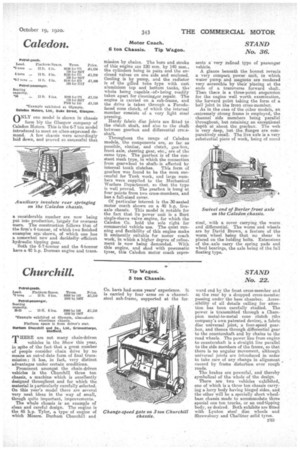Caledon.
Page 41

If you've noticed an error in this article please click here to report it so we can fix it.
Motor Coach.
,6 ton Chassis. Tip Wagon.
STAND No. 36.
*Example exhibited at Olympia. Cateden Motors, Ltd., Duke Street, Glasgow.
ONLY one model is .shown in chassis form bly the Glasgow company of Caledon Motors. This is the 6-7 ton model introduced to meet an often-expressed demand. A few dmisis were accordingly laid down, and proved so successful that
a considerable number are now being put into production, largely for overseas users. The construction follows that. of the firm's 4-tonner, of which two finished examples are: shown, of which one has a somewhat new and decidedly-efficient hydraulic tipping gear. Both the 6-7-termer and the 4-tonner have a 40 h.p. Dorman engine and trans mission by chains. The bore and stroke of this engine are 120 mm. by 140 mm., the cylinders being in pairs and the enclosed valves on one side and enclosed. Cooling is by pump, and the radiator is of the gilled tube type with cast aluminium top and bottom tanks, the whole being capable being readily taken apart for cleaning;or repair. The engine is carried on a sub-frame, and the drive is taken through a Ferodofaced cone clutch, of which the internal member consists of a very light steel pressing.
Hardy fabric disc joints are fitted to the clutch shaft, and also to the shaft between gearbox and differential cro‘sshaft.
Throughout the range of Caledon models,, the components are, so far. as possible, similar, and clutch, goat box, front axle, steering gear, etc., are of the same type. The gearbox is of the constant mesh type, in which the connection from gearwheel to -shaft, is effected by
internal tooth clutches. This form of gearbox was found to be the most successful for Tank work, and large numbers were supplied to the Mechanical Warfare Department., so that the type is well proved. The gearbox is hung at four points from two cross-members, and has a full-sized cover.
Of particular interest is the 30-seated meter coach shown on a 40 h.p. live' axle chassis. This model is notable for the fact that its power unit is a Burt single-sleeve valve engine, for which the Caledon Co. hold the sole right for commercial vehicle use. The quiet running and flexibility of this engine make it eminently suitable for motor coach work, in which a higher degree of refinement is now being demanded. With this engine, and shod with pneumatic tyres, this Caledon motor coach repre
sent s a very refined type of passenger vehicle.
A glance beneath the bonnet reveals a very compact power unit, in which water pump and magneto are rendered very accessible by their placing at the ends of a transverse forward shaft.. Then there is a three-point suspension for the engine well worth, examination, the forward point taking the form of a ball joint in the front cross-member.
As in the case of the other models, an ,extremely strong frame is employed, the channel side members being parallel throughout, but retaining an exceptional depth at about the gearbox. The web is very deep, but the flanges are comparatively small. The live axle is a very substantial piece of work, being of cored
steel, with a cover carrying the worm and differential. The worm' and wheels are by David Brown, a feature of the worm wheel being that no shear is placed on the holding bolts. Extensions of the,axle carry the spring pads and wheel bearings, the axle being of the full floating type.












































































